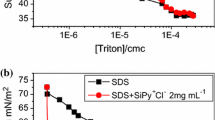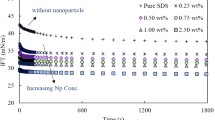Abstract
One of the problems of using surfactant-modified adsorbents in a surfactant-based adsorption process is loss of surfactant because of desorption. Recently, polymerizable surfactants have been used to minimize surfactant losses by polymerization of the surfactant admicellar structure to help secure it to the solid oxide surface. In this study, adsorption of polymerizable cationic gemini surfactant was used to form polymerized bilayers on silica. UV light was used to irradiate and initiate the polymerization process. Surfactant adsorption and desorption were evaluated to compare the efficiency of polymerized and non-polymerized surfactants using gemini and conventional surfactants, respectively. Results demonstrate that the increased stability of the polymerized surfactant-modified surface can reduce the desorption of surfactant from the surface, thereby improving operating characteristics of the surfactant-modified media (e.g., maintaining adsolubilization potential, dispersion stability, etc.).






Similar content being viewed by others
References
Fuangsawasdi A, Charoensaeng A, Sabatini DA, Scamehorn JF, Acosta JE, Osathaphan K, Khaodhiar S (2006) Mixtures of anionic and cationic surfactants with single and twin head groups: adsorption and precipitation studies. J Surfactants Deterg 9:21
Fuangsawasdi A, Charoensaeng A, Sabatini DA, Scamehorn JF, Acosta JE, Osathaphan K, Khaodhiar S (2006) Mixtures of anionic and cationic surfactants with single and twin head groups: solubilization and adsolubilization of styrene and ethylcyclohexane. J Surfactants Deterg 9:21
Fuangsawasdi A, Krajangpan S, Sabatini DA, Acosta JE, Osathaphan K, Tongcumpou C (2007) Effect of admicellar properties on adsolubilization: column studies and solute transport. Water Res 41:1343
Charoensaeng A, Sabatini DA, Khaodhiar S (2008) Styrene solubilization and adsolubilization on an aluminum oxide surface using linker molecules and extended surfactants. J Surfactants Deterg 11:61
Rouse JD, Sabatini DA, Harwell JH (1993) Minimizing surfactant losses using twin-head anionic surfactants in subsurface remediation. Environ Sci Technol 27:2072
Krajangpan S (2004) Enhanced adsolubilization in silica-packed column by mixture of cationic and anionic surfactants. Master thesis, Graduate School, Chulalongkorn University
Oda R, Huc I, Candan SJ (1997) Gemini surfactants, the effect of hydrophobic chain length and dissymmetry. Chem Commun 2105
Hait SK, Moulik SP (2002) Gemini surfactants: a distinct class of self-assembling molecules. Curr Sci 82:1101
Zana R (2002) Dimeric and oligomeric surfactants behavior at interfaces and in aqueous solution: a review. J Colloid and Interf Sci 97:205
Elbert R, Folda T, Ringsdorf H (1984) Saturated and polymerizable amphiphiles with fluorocarbon chains. Investigation in monolayers and liposomes. J Am Chem Soc 106:7687
Laschewsky A, Ringsdorf H, Schmidt G (1985) Polymerization of hydrocarbon and fluorocarbon amphiphiles in Langmuir–Blodgett multilayers. Thin solid film 134:153
Frey W, Schneider J, Ringsdorf H, Sackmann E (1987) Preparation, microstructure, and thermodynamic properties of homogeneous compound monolayers of polymerized and monomeric surfactants on the air/water interface and on solid substrates. Macromolecules 20:1312
Grady BP, O’Rear EA, Penn LS, Pedicini A (1989) Polymerization of styrene-isoprene on glass cloth for use in composite manufacture. Polym Compos 19:597
Esumi K, Watanabe N, Meguro K (1989) Polymerization of surfactant bilayer on alumina using a polymerizable surfactant. Langmuir 5:1420
Esumi K, Watanabe N, Meguro K (1991) Polymerization of styrene adsolubilized in polymerizable surfactant bilayer on alumina. Langmuir 7:1775
Esumi K, Nakao T, Ito S (1993) Fixation of polymerizable surfactant on alumina by uv irradiation. J Colloid and Interf Sci 156:256
Zana R, Yiv S, Kale KM (1980) Chemical relaxation and equilibrium studies of association in aqueous solutions of bolaform detergents. 3. docosane-1,22-bis(trimethylammonium bromide). J Colloid and Interf Sci 77:456
Alami E, Beinert G, Marie P, Zana R (1993) Alkanediyl-α,ω-bis(dimethylalkylammonium bromide) surfactants. 3. behavior at the air–water interface. Langmuir 9:1465
Atkin R, Craig VSJ, Wanless EJ, Biggs S (2003) Mechanism of cationic surfactant adsorption at the solid–aqueous interface. Adv Colloid Interf Sci 103:219
Akbey C, Gill N, Powe A, Warner IM (2005) Monomeric and polymeric anionic gemini surfactants and mixed surfactant systems in micellar electrokinetic chromatography, Part I: Characterization and application as novel pseudostationary phases. Electrophoresis 26:415
Kunitake T, Nagai M, Yanagi H, Takarabe K, Nakashima N (1984) Bilayer formation by aggregation of polymeric amphiphiles. Macromol Sci Chem A21:1237
Pindzola BA, Jin J, Gin D (2003) Cross-linked normal hexagonal and bicontinuous cubic assemblies via polymerizable gemini amphiphiles. J Am Chem Soc 125:2940
Abe M, Tsubone K, Koike T, Tsuchiya K, Ohkubo T, Sakai H (2006) Polymerizable cationic gemini surfactant. Langmuir 22:8923
Rosen MJ, Mathias JH, Davenport L (1999) Aberrant aggregation behavior in cationic Gemini surfactants investigated by surface tension, interfacial tension, and fluorescence methods. Langmuir 15:7340
Pongprayoon T, Yanumet N, O’Rear EA (2002) Admicellar polymerization of styrene on cotton. J Colloid and Interf Sci 249:227
Kosmulski M (2000) Surface charge and zeta potential of silica in mixtures of organic solvents and water. In: Papirer E (ed) Adsorption on silica surfaces. Surfactant Science Series, vol 90. Dekker, New York
Attaphong C (2006) Adsorption and adsolubilization of polymerizable surfactant onto aluminum oxide surface. Master thesis, Graduate School, Chulalongkorn University
Paria S, Khilar KC (2004) A review on experimental studies of surfactant adsorption at the hydrophilic solid–water interface. Adv Colloid Interf Sci 110:75
Schemehorn JF, Schechter RS, Wade WH (1981) Adsorption of surfactants on mineral oxide surfaces from aqueous solutions: isometrically pure anionic surfactants. J Colloid and Interf Sci 85:463
Acknowledgments
Financial support for this work was provided by National Center of Excellence for Environmental and Hazardous Waste Management (NCE-EHWM), Chulalongkorn University, Thailand. In addition, financial support for this research was received from The 90th Year Anniversary of Chulalongkorn University (Ratchadaphiseksomphot Endowment Fund), Chulalongkorn University, Thailand. Financial support was also received from the industrial sponsors of the Institute for Applied Surfactant Research (IASR), University of Oklahoma, USA, including Akzo Noble, Clorox, Conoco/Phillips, Church & Dwight, Ecolab, Halliburton, Huntsman, Oxiteno, Proctor & Gamble, Sasol, Shell, and Unilever. In addition, funds from the Sun Oil Company Chair (DAS) at the University of Oklahoma helped support this research. Finally, many thanks are extended to Dr. Kazuyuki Tsubone and Dr. Abe Mazahiko from Tokyo University of Science, Tokyo, Japan who supplied the samples of polymerizable surfactants used in this research.
Author information
Authors and Affiliations
Corresponding author
About this article
Cite this article
Asnachinda, E., Khaodhiar, S. & Sabatini, D.A. Effect of Ionic Head Group on Admicelle Formation by Polymerizable Surfactants. J Surfact Deterg 12, 379–386 (2009). https://doi.org/10.1007/s11743-009-1125-7
Received:
Accepted:
Published:
Issue Date:
DOI: https://doi.org/10.1007/s11743-009-1125-7




